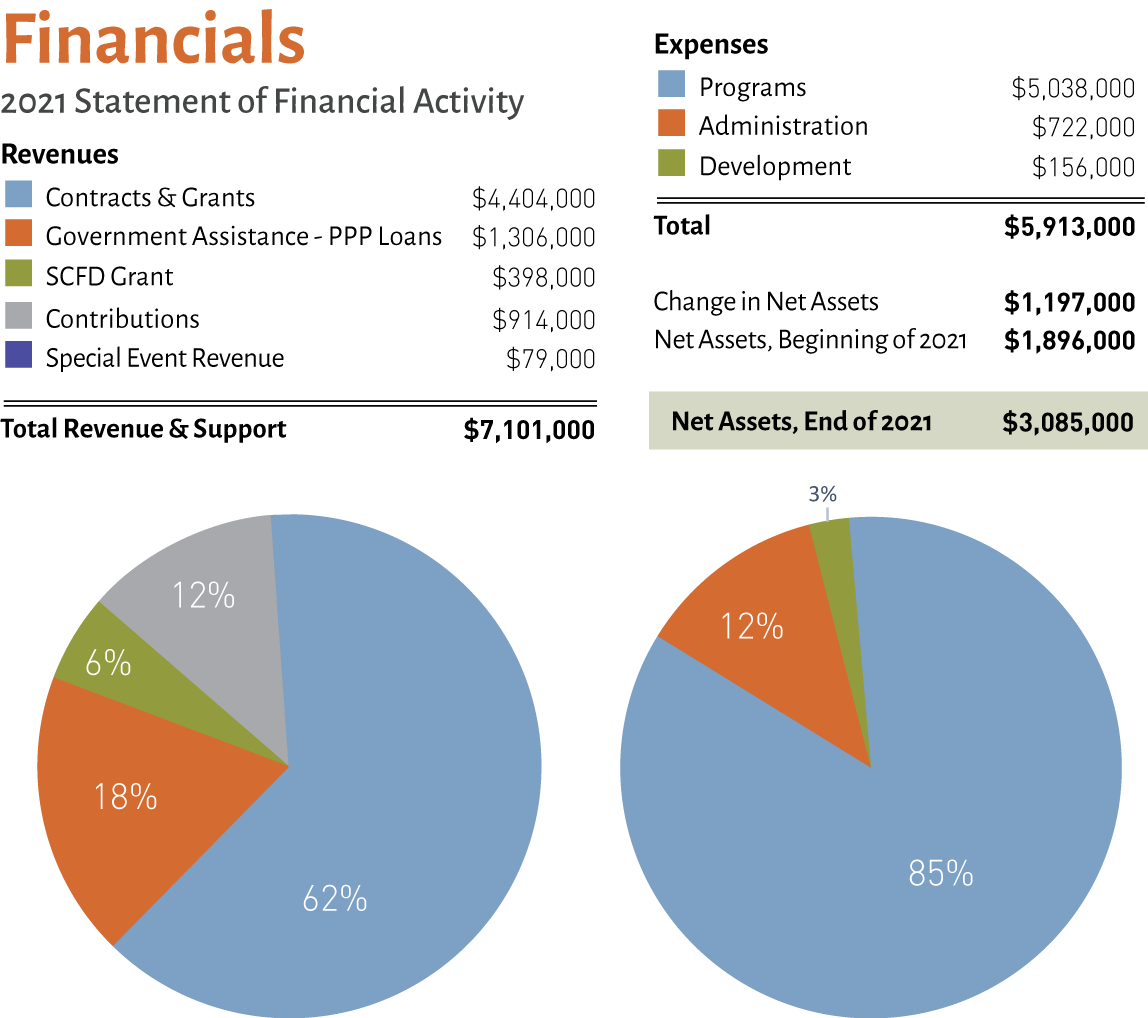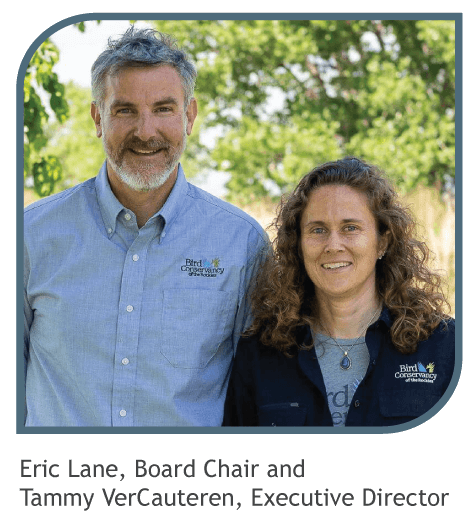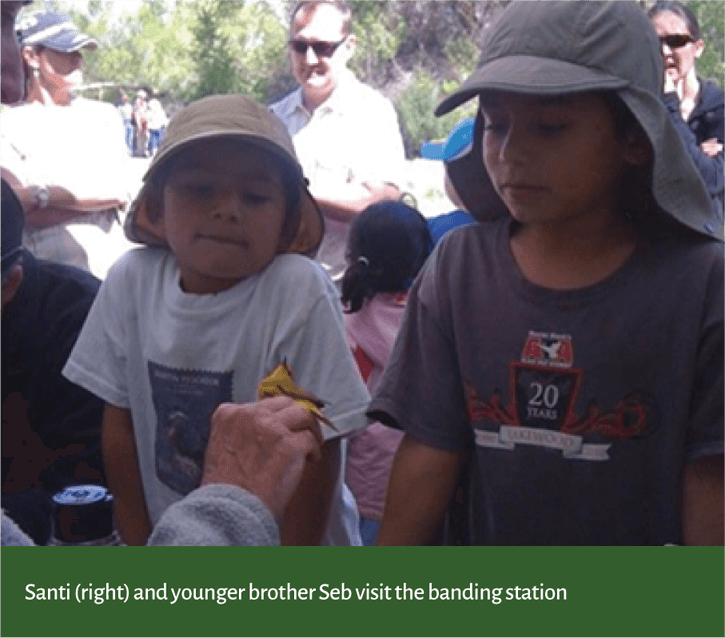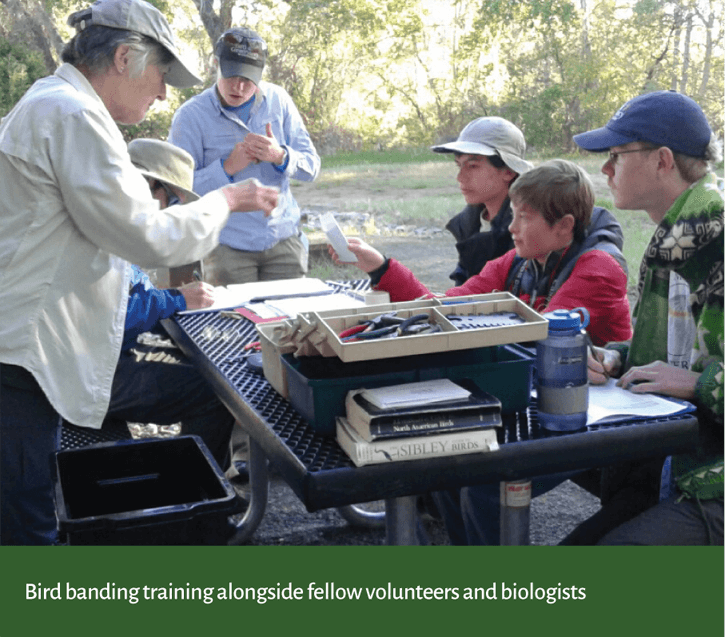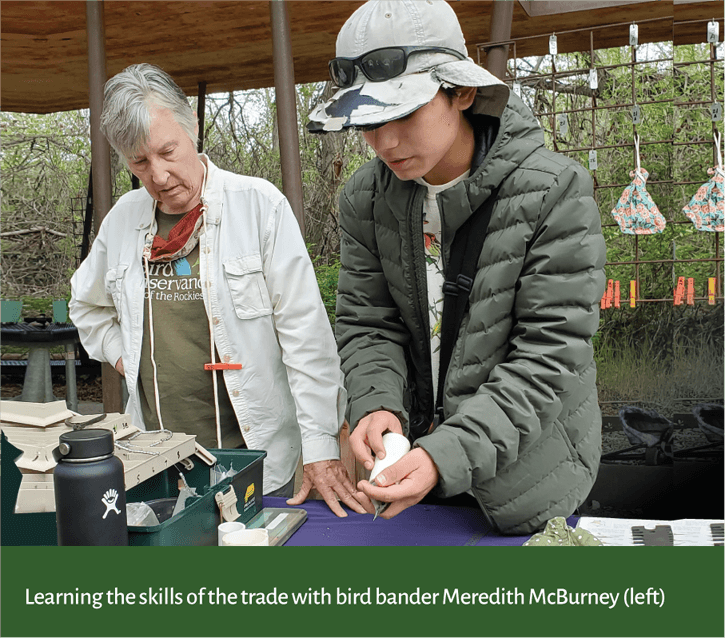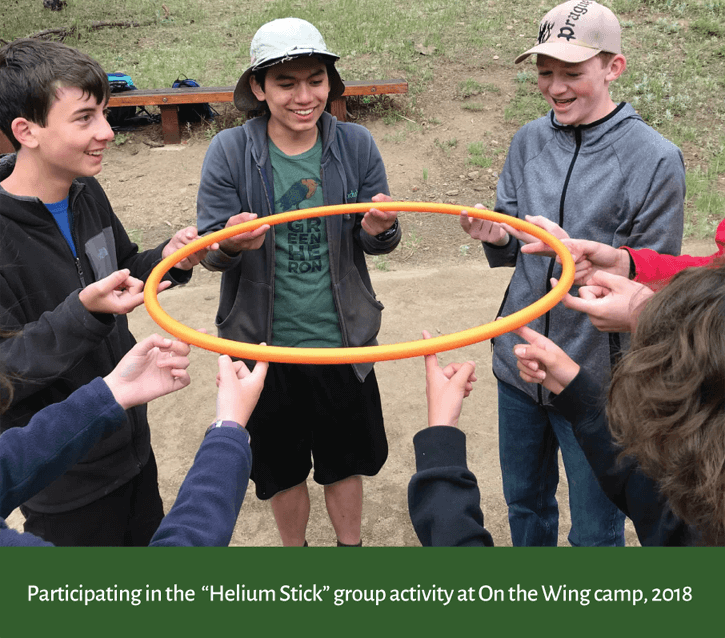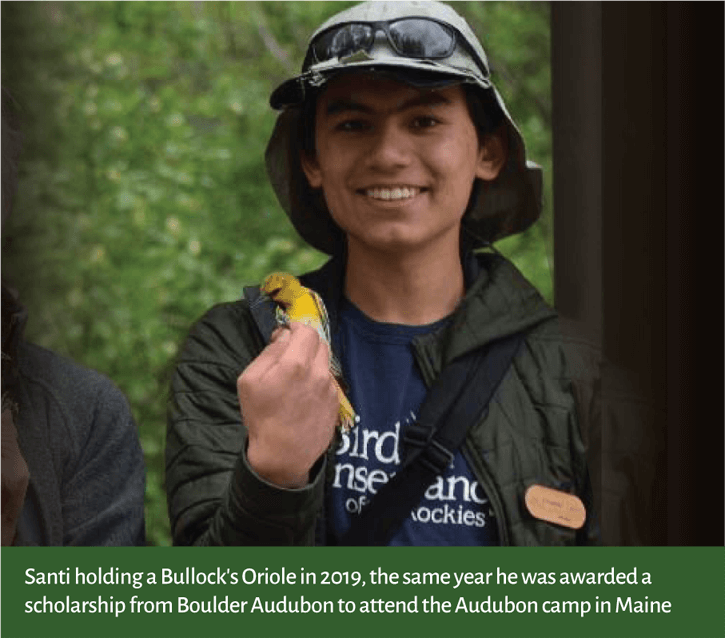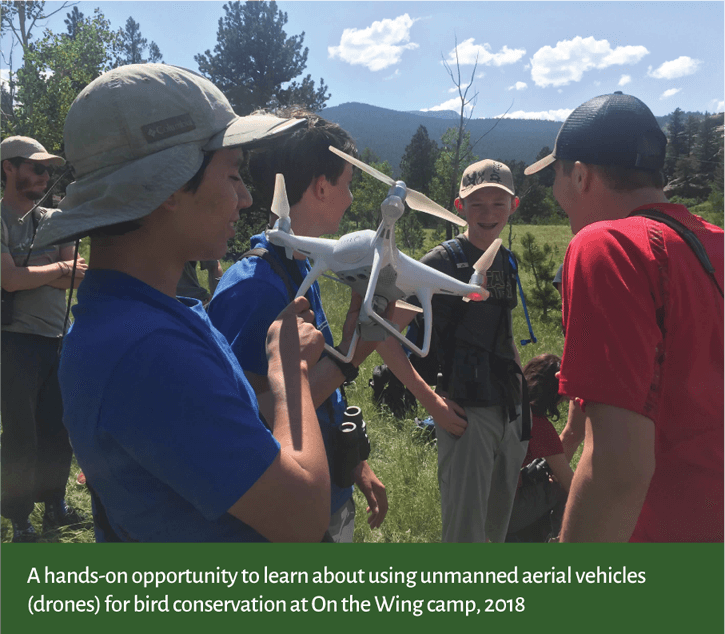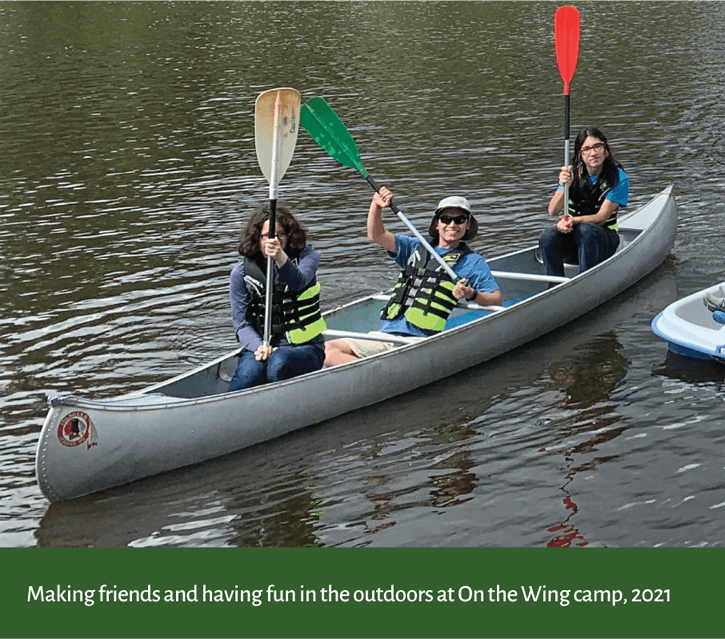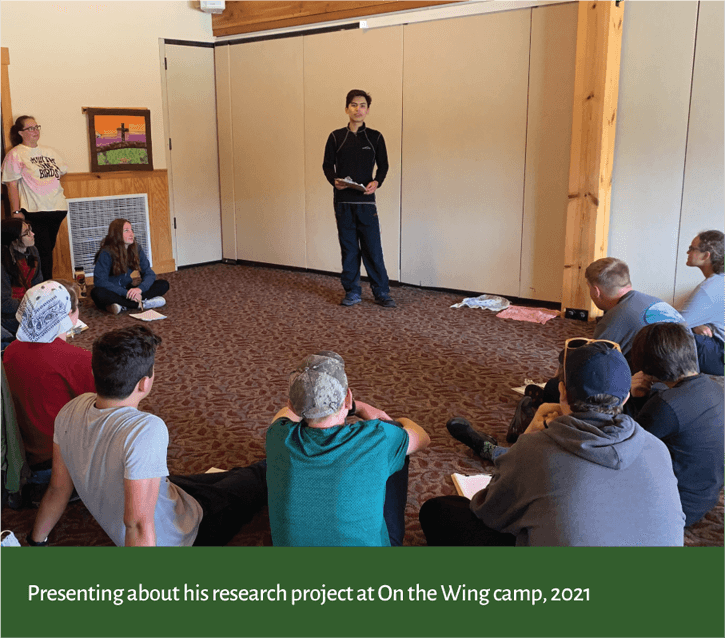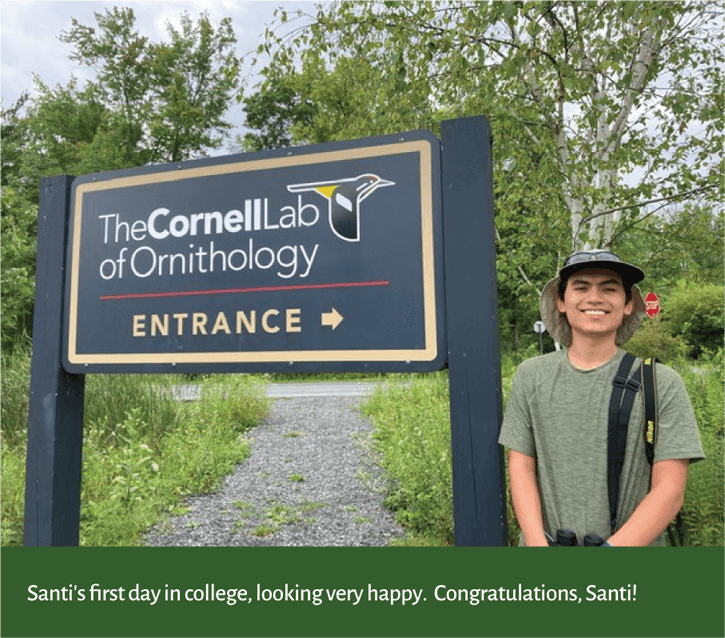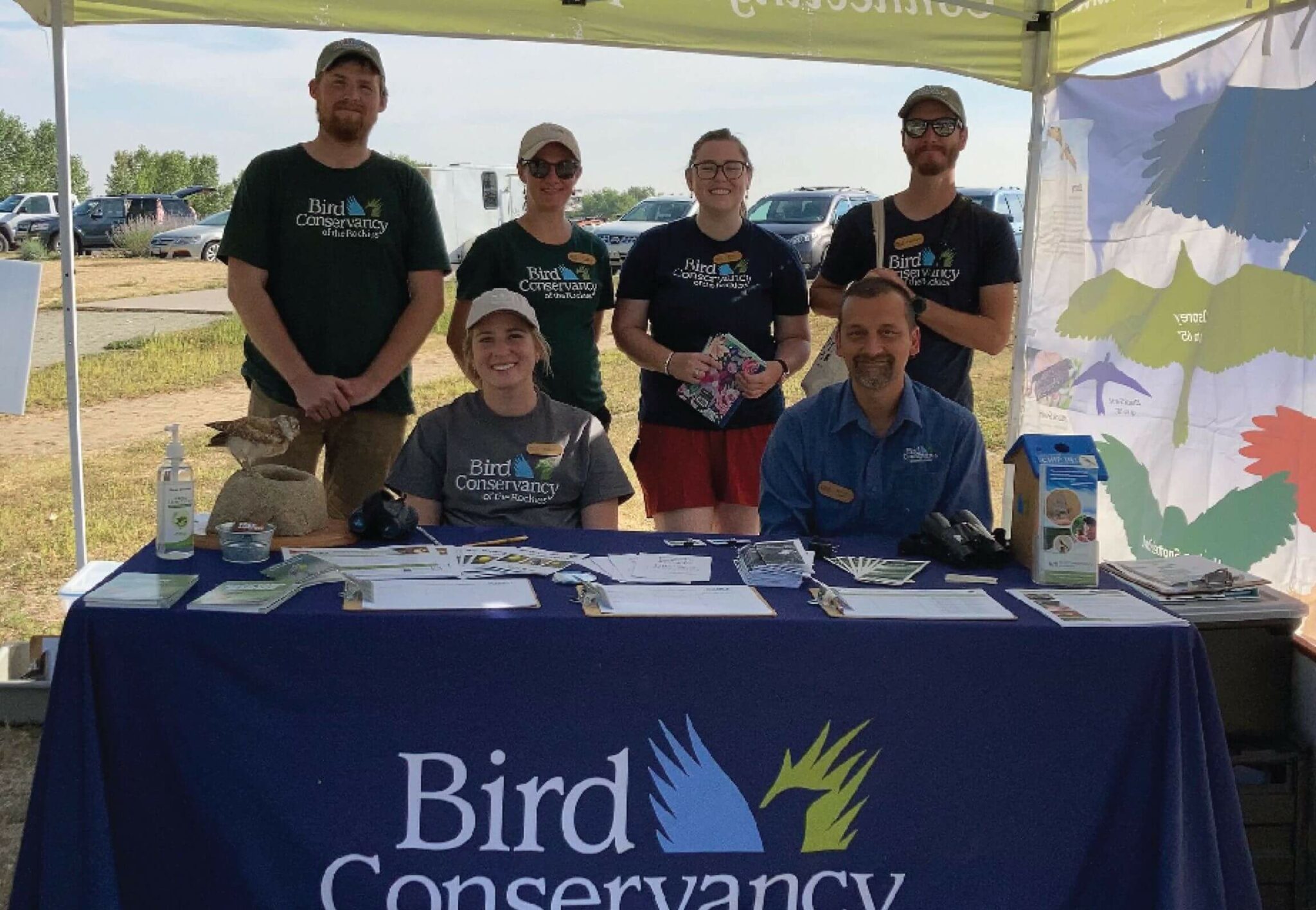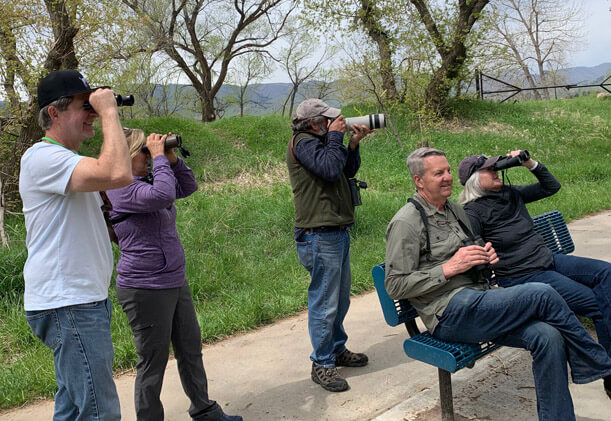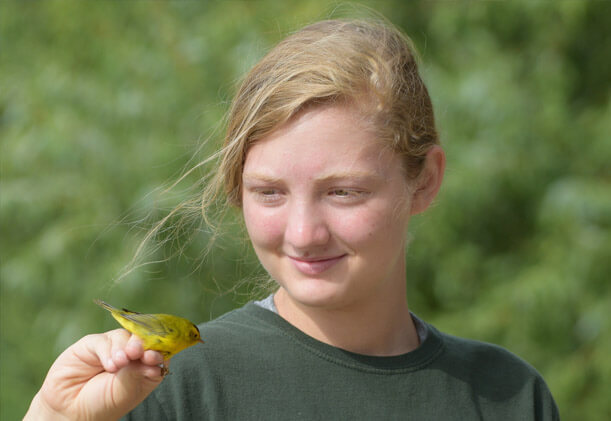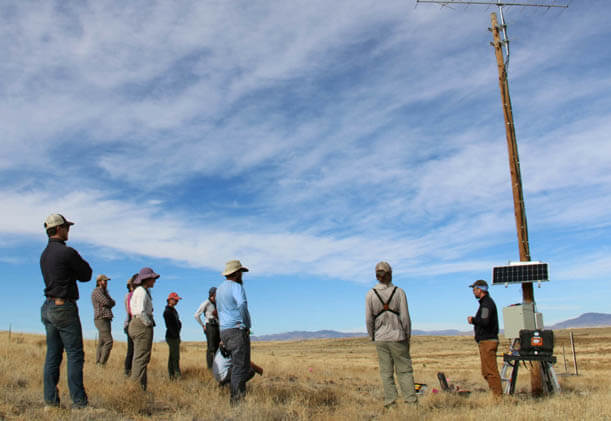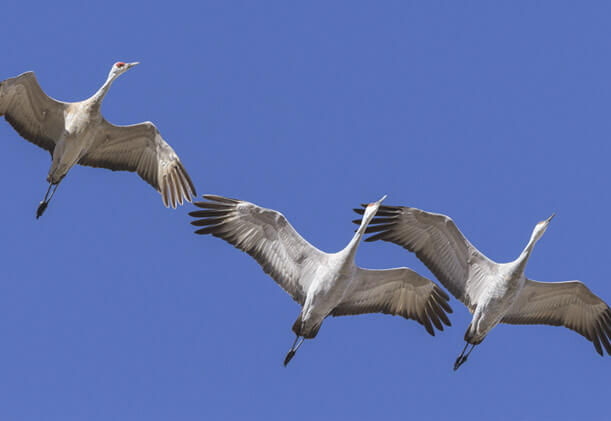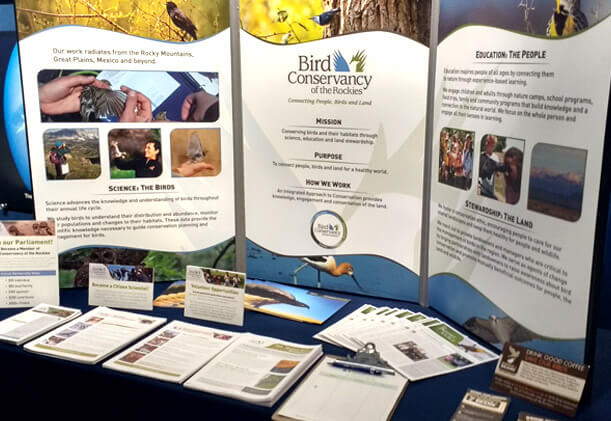BIRD CONSERVANCY OF THE ROCKIES

Message from the Director and Board Chair
Partnerships are a critical part of how we achieve our mission of conserving birds and their habitat. Throughout this annual report, you will see examples that highlight how, working together at small and large scales, we’re achieving sustainable conservation.
Immersing people in nature has partnerships at its core. We work to inspire and grow people in the outdoors, fostering connections and inspiration in collaboration with Barr Lake State Park, Adams County, and other partners across the Denver-metro area and beyond. Our new partnership with the Colorado Association of Environmental Educators has enabled us to add staff capacity and broaden community relationships to remove barriers to participation—such as language—in our programs.
Community science relies on a network of volunteer partners. Recently, Colorado Parks and Wildlife (CPW) increased their investment in our Bald Eagle Watch program to grow the ranks from a couple dozen volunteers to more than 75. In addition, adapting our training and improving our digital data collection has ensured stronger data sharing and integration with partners across the Front Range. CPW and others rely on quality data to manage Bald Eagle populations alongside a growing urban footprint.
Partnering comes in the form of bringing disciplines together to inform and evaluate land stewardship efforts. Our Science and Stewardship teams are collaborating along the urban forest front to conduct thinning practices to mimic historic forest health conditions to improve wildlife habitat and resiliency. We monitor and evaluate subsequent bird responses to help inform management by partners including the U.S. Forest Service, CPW and the Natural Resources Conservation Service.
Partnerships bring people together to change the plight of bird populations. Bird Conservancy is helping lead the way on recovery efforts for declining bird populations. Working with biological and social scientists across the country, we developed a co-production model that brings multiple disciplines and values to the conversation and conservation equation. We continue to spearhead efforts for grassland conservation through the Central Grassland Roadmap. The effort brings countries, Sovereign First Nations and Indigenous communities, states, federal agencies, academia, landowners and more together to ensure resilient grasslands for our future. Elevating voices, culture, knowledge and aligning on priorities ensures a collaborative and strategic approach to conservation going forward.
Your partnership, support and investment is changing opportunities for people and improving the places where we live and landscapes we love. Together, we can ensure declining bird populations stabilize, engagement and opportunities are available across communities, and achieve conservation now and for the future. Thank you for making the stories, results and outcomes possible.
BY THE NUMBERS
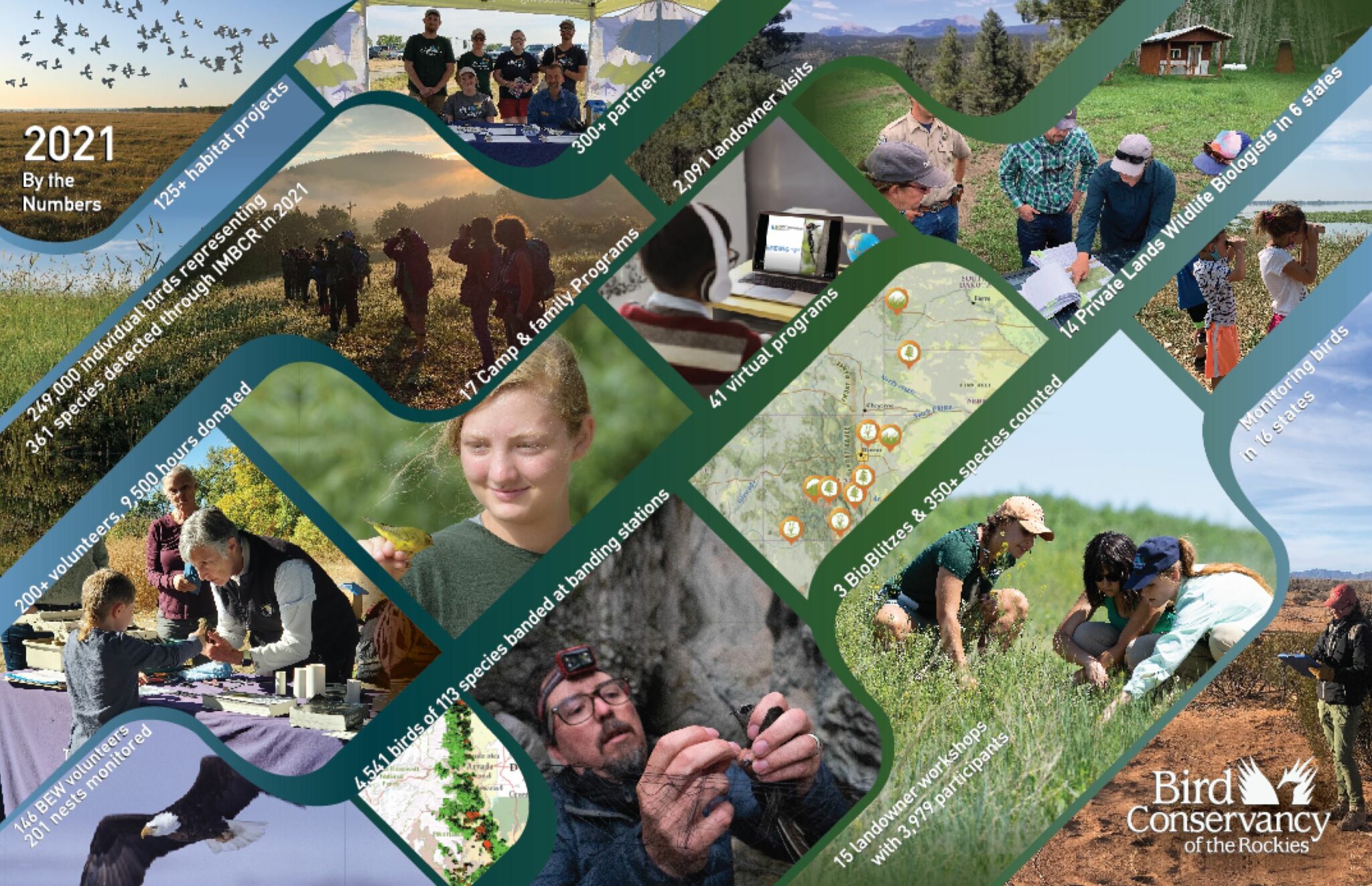
2021 Stories and Accomplishments
SCIENCE

CHARTING THE ROAD TO RECOVERY
Developing New Conservation Paradigms to Reverse Bird Population Declines
The documentation of three billion birds lost since 1970 underscored that our conservation efforts to prevent declines and recover North American bird populations have not been effective. The Road to Recovery (R2R) initiative, a cooperative of scientists and conservation delivery experts from state, federal, academic, and non-profit sectors was born from the realization that bird conservation needed to be reimagined.
R2R focuses on facilitating a paradigm shift that uses targeted and actionable science to recover North American bird populations. This approach relies on co-production and effective communication to develop collaborative conservation solutions jointly informed by the biological causes of decline and social barriers to implementation.
This work elevates at a national level Bird Conservancy’s long history of using actionable science to ensure conservation solutions that support both biological diversity and human wellbeing.
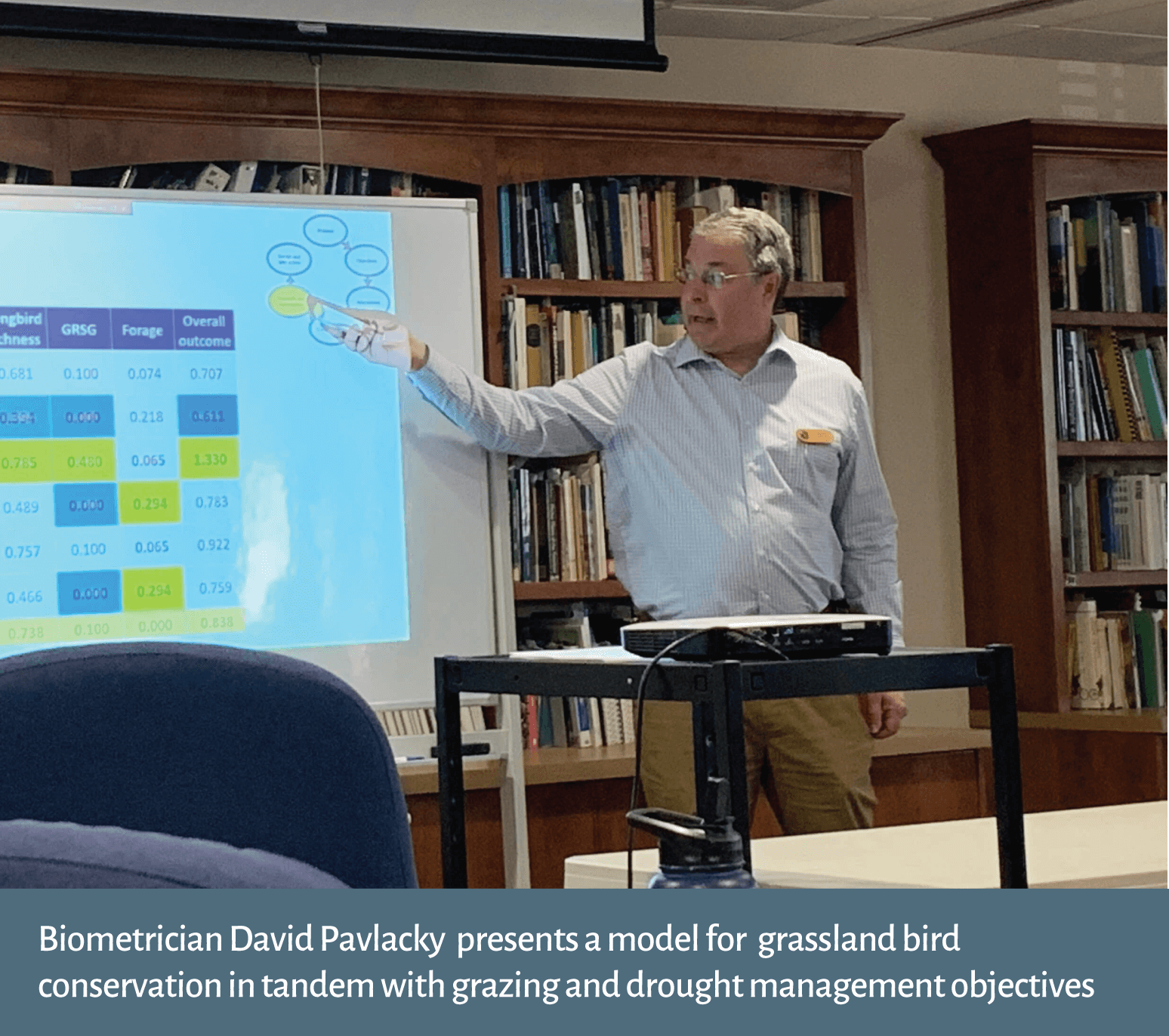
A recent example is a structured decision-making workshop led by Bird Conservancy scientists, David Pavlacky and Jen Timmer. The workshop brought together private landowners, biologists, economists, and federal partners to develop collaborative conservation solutions to support resilient and biodiverse grasslands. Specifically, this effort aims to integrate bird abundance and habitat models with data on the economic implications of alternate grazing systems and drought management strategies. By understanding diverse stake holder objectives, we are developing co-produced research projects that address key resource issues and subsequently implement those best management practices in way that jointly supports human and bird needs.
2021 Science Highlights
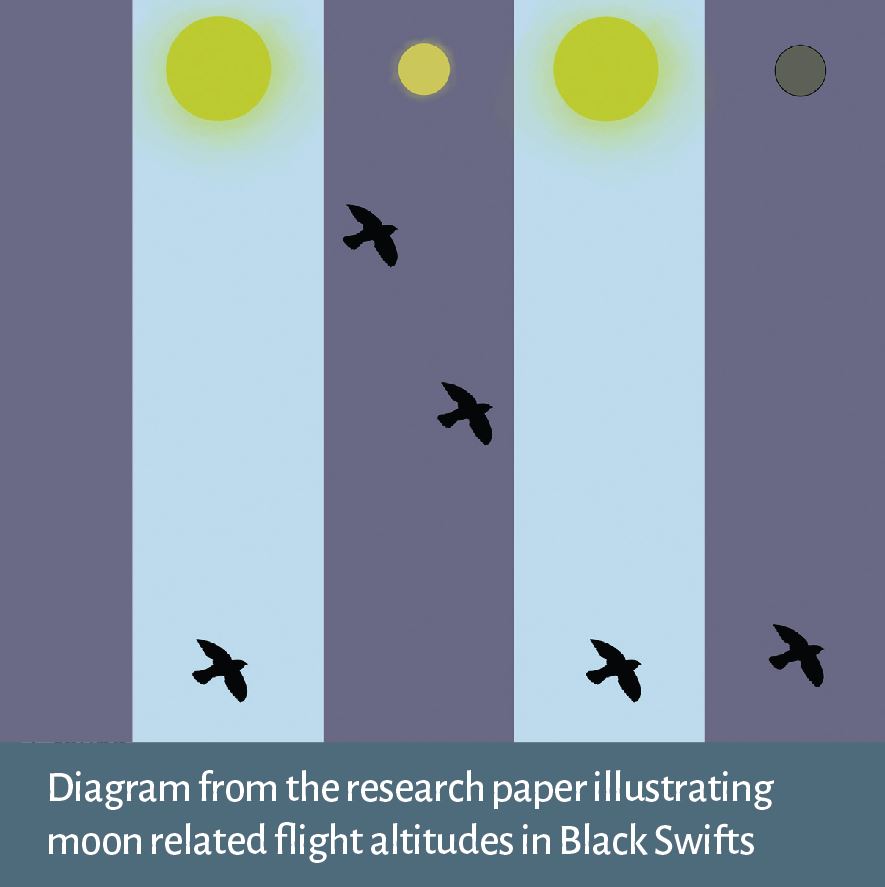
Discovering Unique Flight Behavior
Black Swifts conjure the mastery of flight, flying non-stop over the Amazon during the non-breeding season without landing, roosting in the air like their European swift counterparts. Bird Conservancy collaborated with Lund University to study Black Swift flight patterns during the non-breeding season, leading to the discovery of a novel behavior not observed in birds before. We deployed multi-sensor biologgers that measure light for geolocation, acceleration for wing activity, and pressure for flight altitude. During periods near the full moon, Black Swifts conducted regular nocturnal ascents to altitudes up to >4,000 meters. A lunar eclipse triggered a synchronized descent, showing a direct effect of moonlight on flight altitude. Increased nocturnal flight activity during periods of moonlit nights suggests swifts were hawking for prey. This broadens our understanding of flight dynamics and provides a stepping stone to test whether other migratory insectivores have evolved similar behaviors. Furthermore, these findings highlight the need to consider the aerosphere when developing conservation plans.
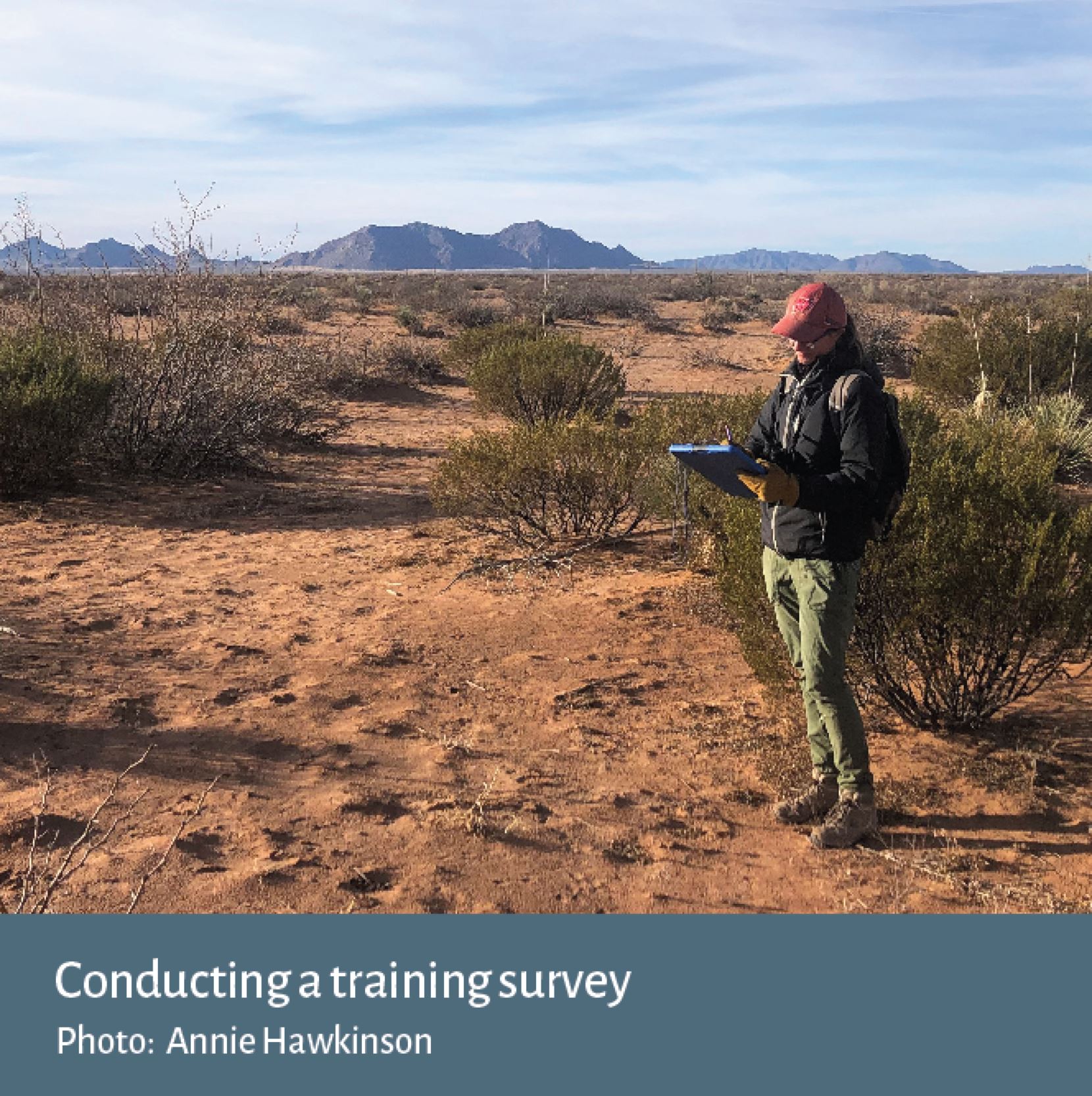
Coming Together for Grassland Birds
Grassland bird populations are in steep decline and those that winter in the Chihuahuan Desert specifically, have declined more than birds that winter elsewhere. Bird Conservancy’s non-breeding grassland bird monitoring program aims to address these alarming trends by establishing baseline population estimates for focal species on their wintering grounds in the Chihuahuan Desert, and tracking changes in populations across years and habitat types. In 2021, our program expanded significantly and we were excited to spend the winter tracking cryptic sparrows and flocks of longspurs throughout the Chihuahuan Desert of New Mexico, Texas, and several states in northern Mexico. Our crew of seasonal employees, along with contracted partners and collaborators, conducted surveys using a singular design and protocol. We provided in-person training and resources in both English and Spanish so that observers recorded data consistently. Despite the continued challenges of COVID-19, everyone met their survey goals and we look forward to digging into the data this spring and applying what we learn to grassland bird conservation efforts.
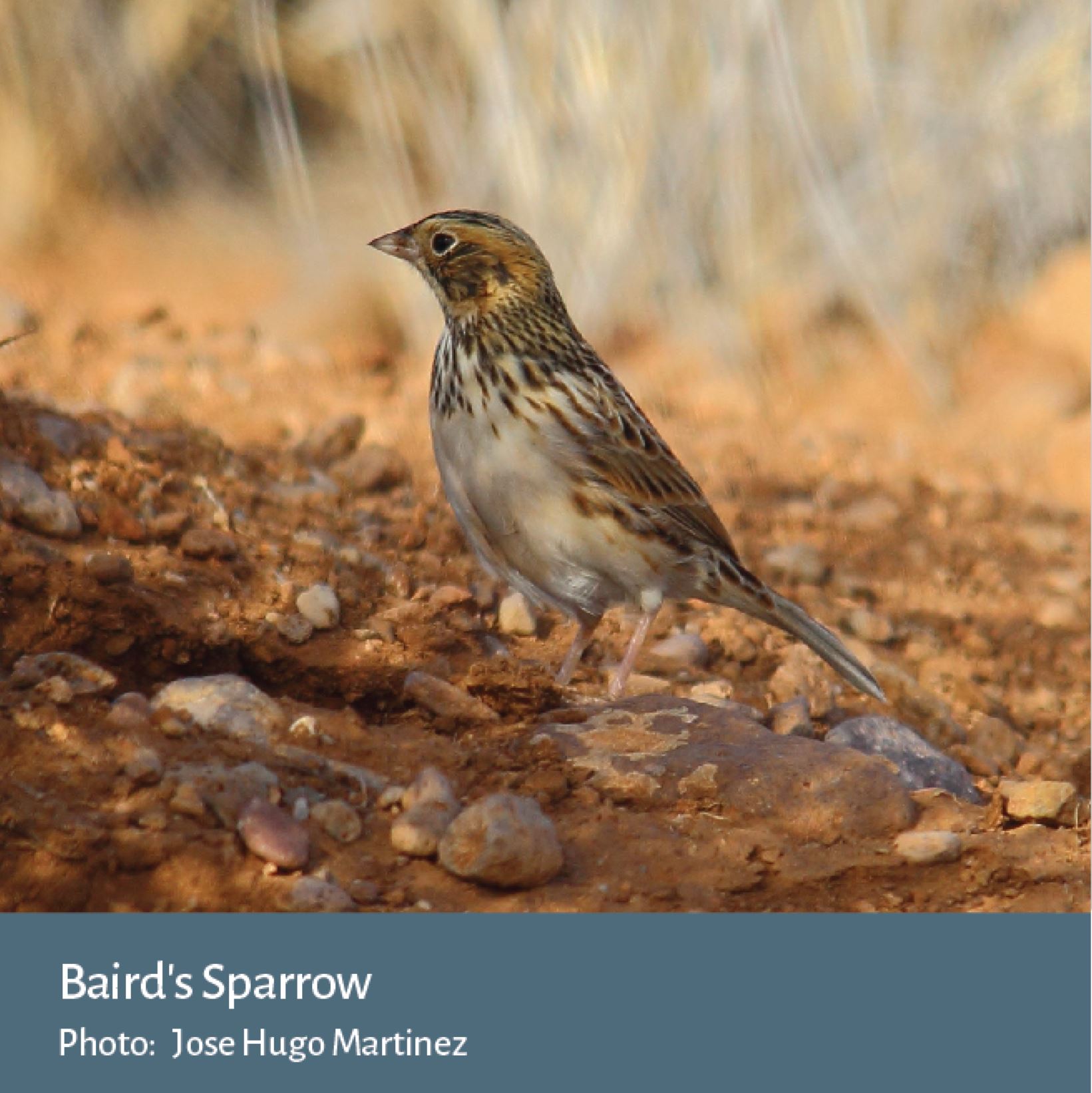
Developing Open-Population Models
Knowledge of demography and movement is key for identifying sites with conservation priority and developing conservation strategies that benefit birds. Traditionally, gaining that information relies on capture-based data that are costly to collect. Recent advantages in statistical ecology make it possible to gain such knowledge from count data of unmarked animals. However, observation errors still create challenges to accuracy. The unique design of Bird Conservancy’s Integrated Monitoring in Bird Conservation Regions enables the separation of observation errors from true abundance of surveyed animals, and thus are useful for better understanding of ecological patterns and mechanisms. Open-population models to analyze these data and estimate movement and demographics for a suite of grassland bird species. Our goal is to use these models to evaluate the effectiveness of habitat conservation programs, and to prioritize areas within the broader landscape in which to implement different conservation actions aimed at stabilizing or recovering declining populations.
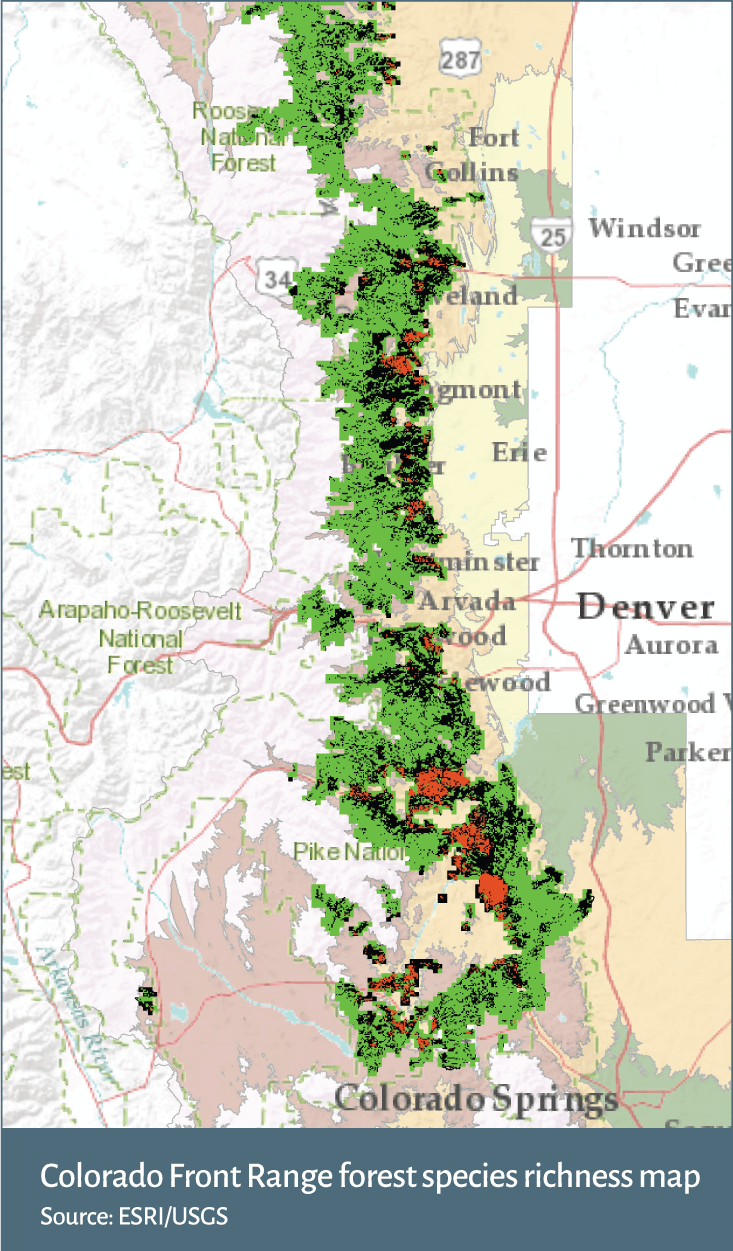
Mapping Opportunities for Forest Restoration
Bird Conservancy continued to provide high-quality information for restoration and management of Colorado Front Range forests most at risk of loss from severe wildfire. Fire suppression, logging, grazing, climate change, and other stressors have compromised ecological structure and function of forests, threatening their loss. Restoration treatments reduce vegetation density and encourage large trees using mechanical thinning and prescribed fire, making forests more resilient to wildfire.
Previously, we collaborated with U.S. Forest Service Region 2 and the Colorado Forest Restoration Institute in documenting benefits of forest restoration for birds. In 2021, we built on this work and collaborated with the Natural Resource Conservation Service (USDA) to project avian responses to forest management across the Colorado Front Range.
Mapped projections showed opportunities for management to increase bird species richness, and especially richness of ponderosa pine forest specialists, on both public and private forests throughout the Front Range. Conversely, we mapped risk of loss in bird diversity in a relatively small proportion of the landscape. These results bolster growing evidence of benefits of forest restoration and management for dry conifer forest birds, while also showing managers can most benefit conservation while also reducing wildfire hazards for communities along the urban-wildland interface.
EDUCATION

ENCOURAGING THE
NEXT GENERATION
Learning and Leadership Opportunities for Young People
One of our education program objectives is to inspire, foster and support teens who express a strong interest in pursuing careers in conservation, biology, ornithology and related fields. As part of our banding program, we help teens develop a full range of basic banding skills by the time they go off to college.
Santiago Tabares is one such teen. Santi was 8 years old and birds were just becoming a passion for him when his parents first brought him to the banding station. He officially joined our teen banding group at age 14, committing to volunteer one morning each weekend, during spring at Chatfield and fall at Barr Lake. He worked alongside experienced volunteers and staff learning to record data, safely extract birds from the net, and identify, age and sex the many species we catch.
During these years, Santi also participated in Bird Conservancy’s summer camps. By the time he was a senior in high school, Santi was processing birds under the supervision of lead bander Meredith McBurney. Last fall, he began his freshman year at Cornell University, where he is, according to his mother, “having a blast” – birding, working in the specimen lab one day each week, and, of course, studying!
2021 Education Highlights
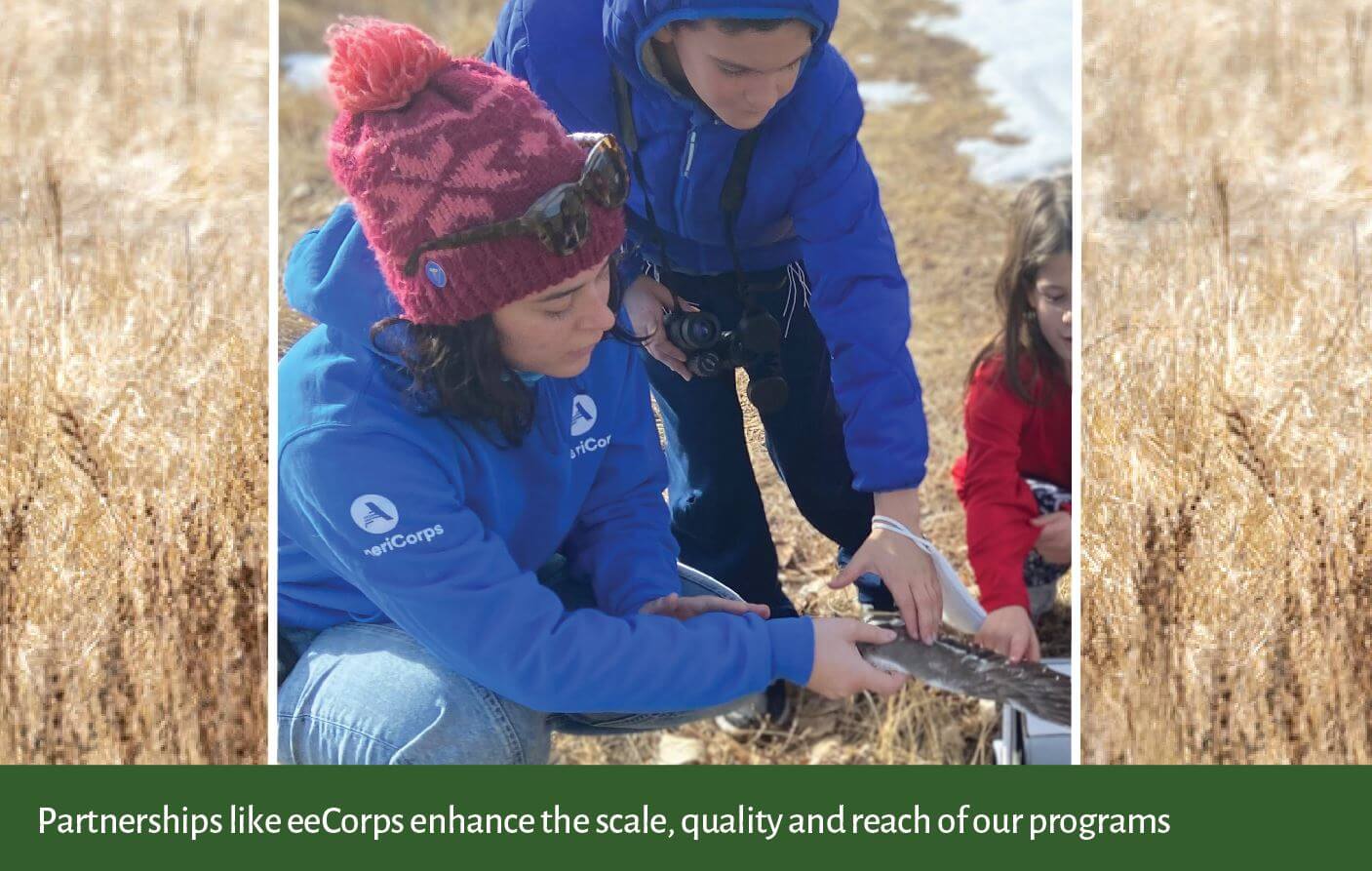
New Partnership Expands Capacity and Reach
Through a partnership with Colorado Alliance for Environmental Education, our Education team recently selected an eeCorps AmeriCorps member to serve as an Environmental Educator at our headquarters in Brighton. Each year a new member will take up the position to help develop and serve the Denver metro area and deliver environmental education programs to Colorado schools and communities. This new partnership is an incredible opportunity for growth, outreach and skill development for AmeriCorps members, the organization, and the local community. The current AmeriCorps member Hannah Jakob has been assisting Sarah Doxon in early childhood education efforts, developing a relationship with Spanish speaking audiences, and working on art-based education methods.
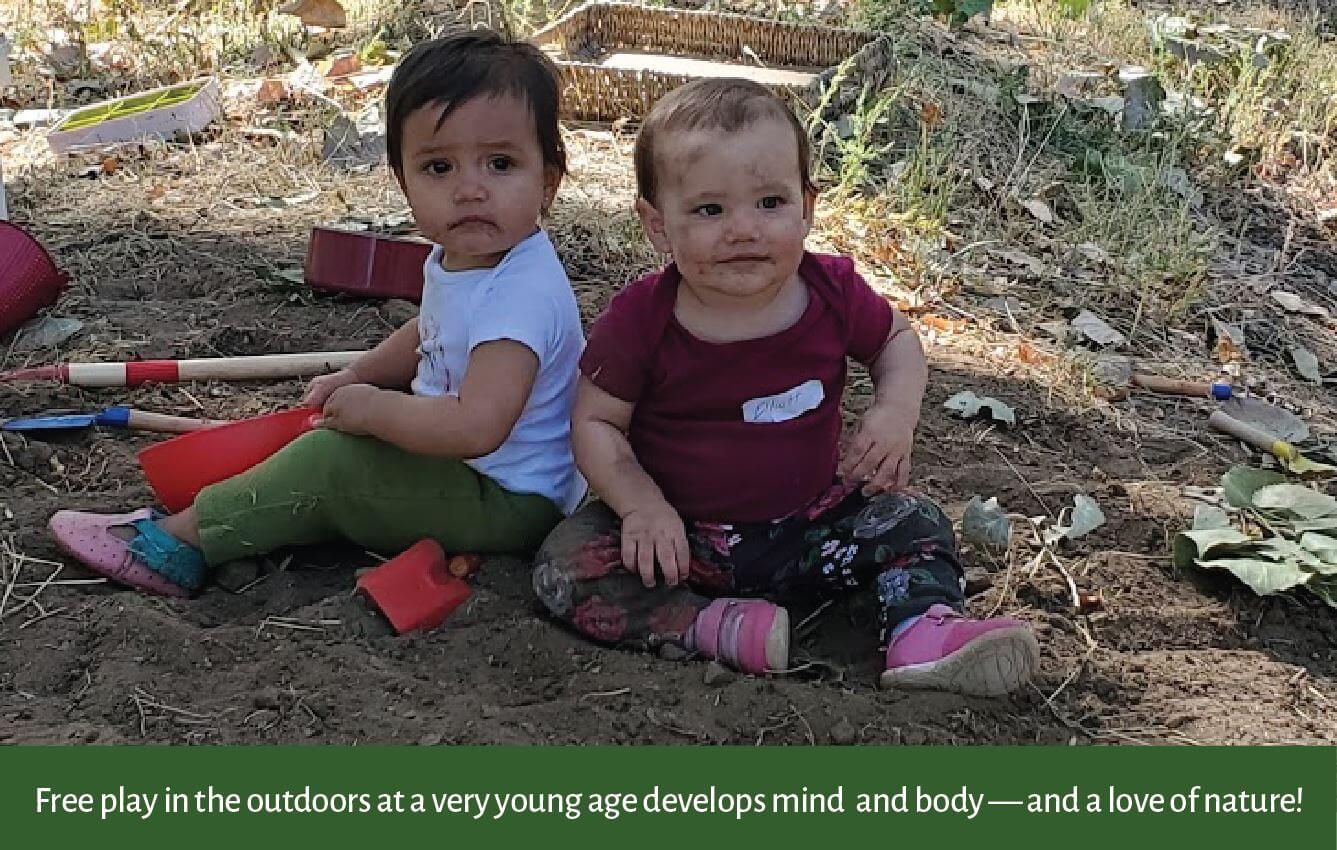
Helping Kids Grow (Naturally)
Playing in nature gives young children the space to explore, take healthy risks, and form meaningful connections with the world around them. Unfortunately, many of today’s children don’t have the opportunity to play in safe, natural spaces. At Bird Conservancy, we want to do our part to change that. In 2021, we launched our early childhood initiative, Growing Naturally. First, we added age-appropriate activities to our existing Family & Homeschool programs. We then began hosting Wild Wednesdays, where families with young children come together for a morning of nature play at the Environmental Learning Center. Our next step is to engage area preschools. Together we can raise the next generation of conservationists and bird lovers!
Bald Eagle Watch
In early 2021, the COVID-19 pandemic hit a winter peak. Vaccines were available only to front-line healthcare staff, and most people had to work, study, and shop from their homes. These conditions posed challenges to the all-volunteer Bald Eagle Watch (BEW) community science program, which has operated continuously since 1988.
Regardless of the COVID pandemic in humans, Bald Eagles in 2021 continued their innate reproductive schedule, from egg-laying in February to the fledging of flight-capable young eagles by July. Our volunteers showed excellent adaptability in following procedures to safely monitor and document these life stage progressions at nearly 160 Bald Eagle nests throughout Colorado. During their monitoring, volunteers were also on the lookout for possible threats to nests and alerted Colorado Parks and Wildlife (CPW) for follow-up.
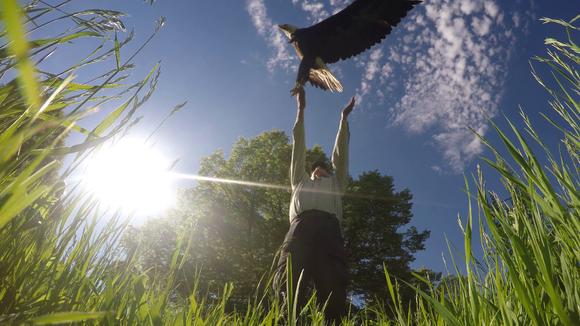
Bruce Snyder releases a bald eagle that researchers placed a GPS-GSM transmitter on in Golden, Colo. Photo by Jason Clay/Colorado Parks and Wildlife.
January’s virtual/online volunteer training has proven popular, and even increased participation. In addition to addressing COVID concerns, we could expand the geographic area and reach more volunteers. In 2021, we had 25 returning members and 51 new participants. BEW volunteers provided 2,982 hours of service over the season as they traveled to nests, observed reproductive progress, and reported results.
Partnerships became an increasingly important part of our program in 2021. To enhance the utility of the eagle observations recorded by our volunteers, BEW standardized procedures and data sharing with programs conducted by CPW; City of Aurora Parks, Recreation, and Open Space; and Boulder County Parks and Open Space. BEW personnel also worked with staff from Colorado State University to improve and beta-test version 2.0 of CitSci.org, CSU’s Internet platform that provides data management functions to more than 1,000 community science projects world-wide.
In 2021, our volunteers were integral to the successful startup of CPW’s 4-year, Front Range Bald Eagle Research Project. BEW observations help CPW scientists identify and capture appropriate nesting bald eagles for fitting with location transmitters, and our volunteers collect complementary data on habitats and activities of the tagged eagles that CPW could not otherwise acquire due to limited resources.
Our volunteers made the 2021 Bald Eagle Watch program a rousing success, even amidst the pandemic. They continued the trend of substantially increased results by monitoring 158 nesting pairs, a gain of 19 nests from 2020. They documented that the 133 successful nests (84%) fledged at least 222 young eagles. Our volunteers supported CPW in the tagging of 20 bald eagles with transmitters, and they continue to provide observations for the 17 birds that are still producing first-of-kind location and habitat use information for bald eagles in Colorado.

Conservation
& Community
Private working farms and ranches comprise 70% of the western landscape, and are home to many of our imperiled grassland birds. That’s why, for more than 20 years, our organization has operated a private lands program working alongside landowners and managers to raise awareness for bird conservation needs and enhance habitat at the local level.
Our collaborative conservation landscape spans the central grasslands, from Canada to Mexico, and is fueled by the expertise of a network of strategically-placed Private Lands Wildlife Biologists (PLWBs) in six states. As members of the communities where they live and serve, PLWBs aim to be a valuable resource to local partners. As such, they are a source of support, tools and resources for landowners to enhance the health and productivity of their working lands for the benefit of wildlife, people and their bottom line.
Click a pin to learn more about our Stewardship team and field offices
2021 Stewardship Highlights
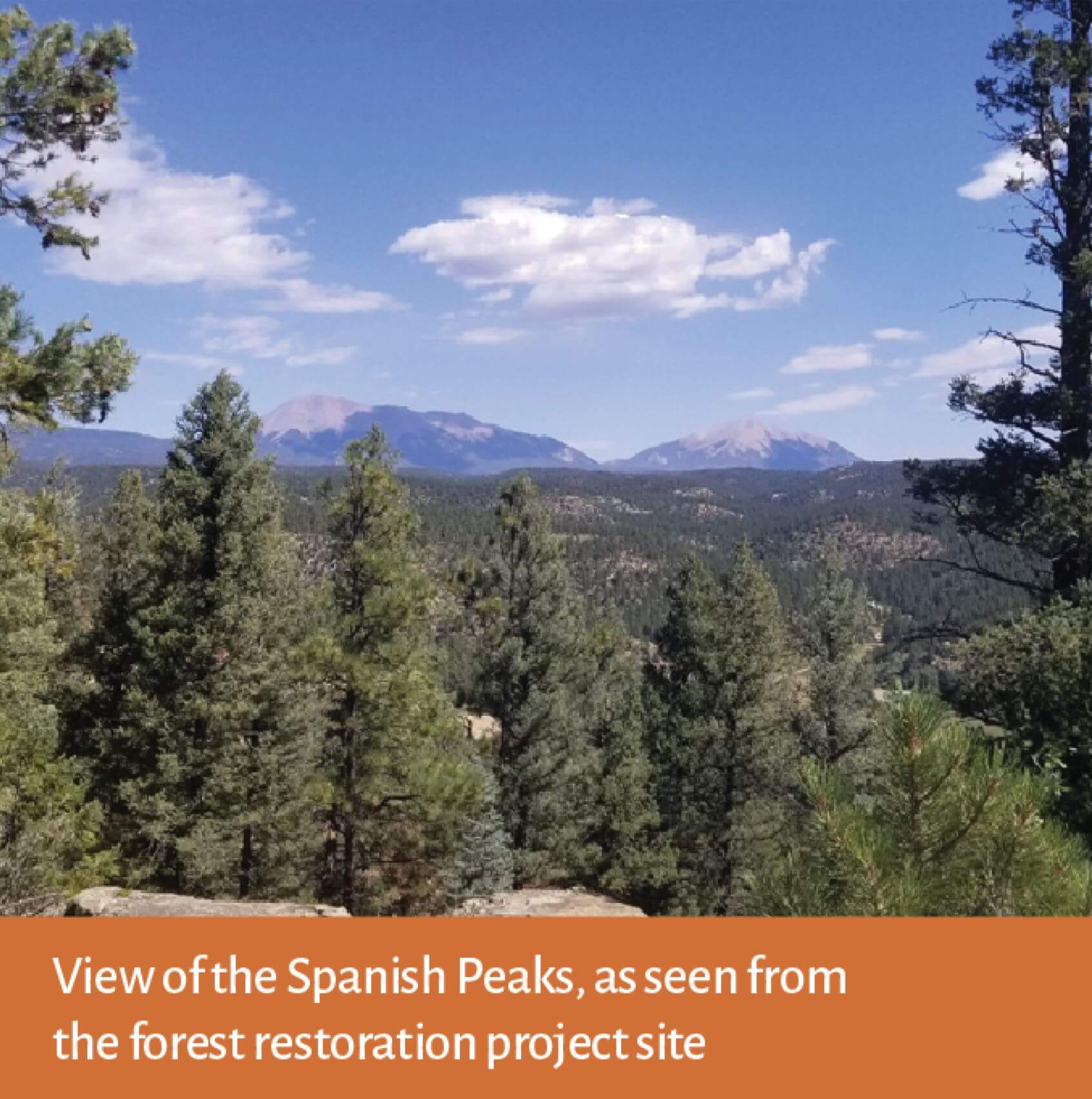
Coming Together for Forest Health
Healthy forests reduce wildfire risk and intensity, and improve habitat for wildlife. Forest restoration increases habitat for forest birds at various stages of tree growth. Some species require a dense understory while others thrive in an open woodland. Forest management projects are big jobs! That’s why Kaitlyn Nafziger, Private Lands Wildlife Biologist in forestry, brought partners together for a 630-acre project near the headwaters of the Purgatoire River. Multiple organizations came together to provide expert knowledge of forest management, forest bird habitat needs and pooled funding. Kaitlyn assisted private landowners in applying for the Environmental Quality Incentives Program (EQIP) allocated in USDA Farm Bill through the Natural Resources Conservation Service (NRCS).Trees were removed mechanically, leaving openings in the forest with trees of varying ages. This improves forest resiliency against wildfires, making it harder for diseases and insects to spread. Opening the canopy gives sunlight to wildflowers and grasses that provide forage for wildlife. Dead standing trees are retained to provide shelter for cavity nesting birds such as Williamson’s Sapsuckers and Western Bluebirds. Purgatoire Watershed Partnership and Bird Conservancy are exploring options to expand the restoration by restoring additional acres.
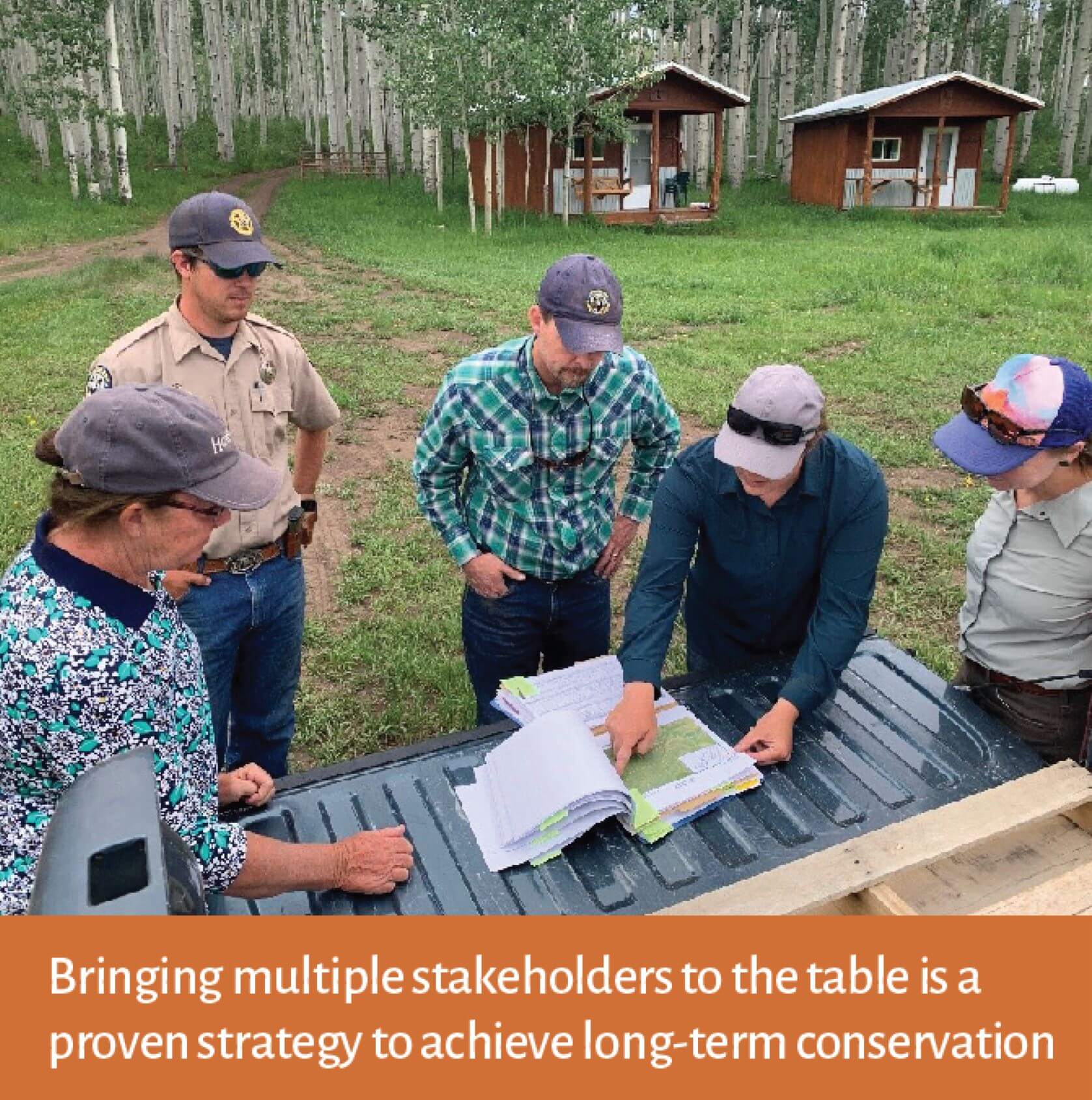
Taking the Higher Ground
Collaborative conservation can be challenging and rewarding. Bringing multiple stakeholders to the table is a proven strategy to achieve long-term conservation. Senior Wildlife Biologist, Marcella Tarantino works with the Neff Family who own and operate the Colorado Higher Ground Ranch. The habitat on their ranch boasts a diverse array of wildlife habitat such as sagebrush, mountain shrub, forest and riparian areas, supporting birds such as Dusky Grouse, Gambel’s Quail, Sagebrush Sparrow, Sage Thrasher, Brewer’s Sparrow, Green-tailed Towhee, and Gunnison’s Sage Grouse. Marcella developed a conservation plan through the Natural Resource Conservation Service (NRCS), and a forest management plan from the Colorado State Forest Service (CSFS). NRCS, U.S. Fish and Wildlife Service, and Colorado Parks and Wildlife-Habitat Partnership Program assisted with restoration in sagebrush habitat. Birds benefiting from this comprehensive management plan include Yellow, Orange-crowned, and Yellow-rumped Warblers, as well as common species like robins and Cedar Waxwings. The Neff Family is establishing a conservation easement to conserve wildlife on the ranch and and are inspiring neighbors to partner on conservation projects of their own!
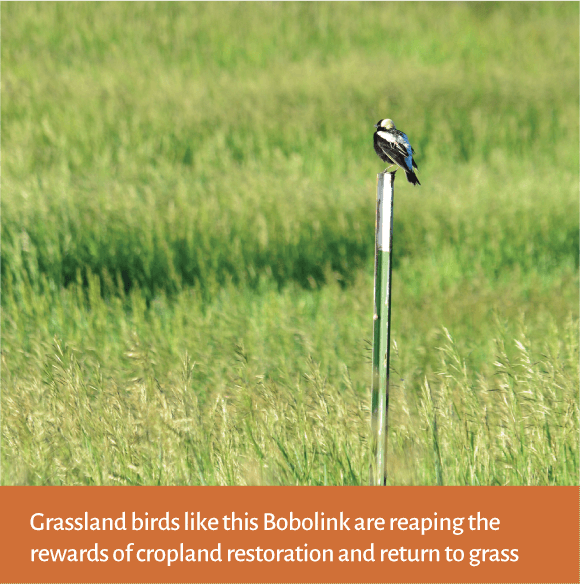
TIPs are appreciated!
The 2021 and 2022 Targeted Implementation Plans (TIPs) in Dawson County, MT direct USDA Farm Bill dollars toward cropland restoration to perennial cover. In partnership with World Wildlife Fund (WWF), the National Fish and Wildlife Foundation (NFWF), and the Natural Resource Conservation Service (NRCS), this focused conservation funding allows private landowners to reseed highly erodible fields back to year-round cover, improving soil quality and developing wildlife habitat. Landowners can also receive funding for fencing and livestock water developments to enable the land to be grazed once stands are established. Currently, 15 landowners have enrolled to reseed nearly 8,000 acres of cropland back to perennial cover, with another two years of enrollment ahead. Where producers reseed to 90% native mixes using partner funding in combination with TIP funds, WWF conducts soil carbon monitoring. On all reseeded acres, Bird Conservancy is conducting bird surveys using the Integrated Monitoring in Bird Conservation Regions (IMBCR) protocol to monitor the effect of reseeding on grassland birds. This approach allows producers to build a healthy ecosystem from the ground up, making land healthier and more productive for generations to come while simultaneously creating habitat for imperiled grassland species.
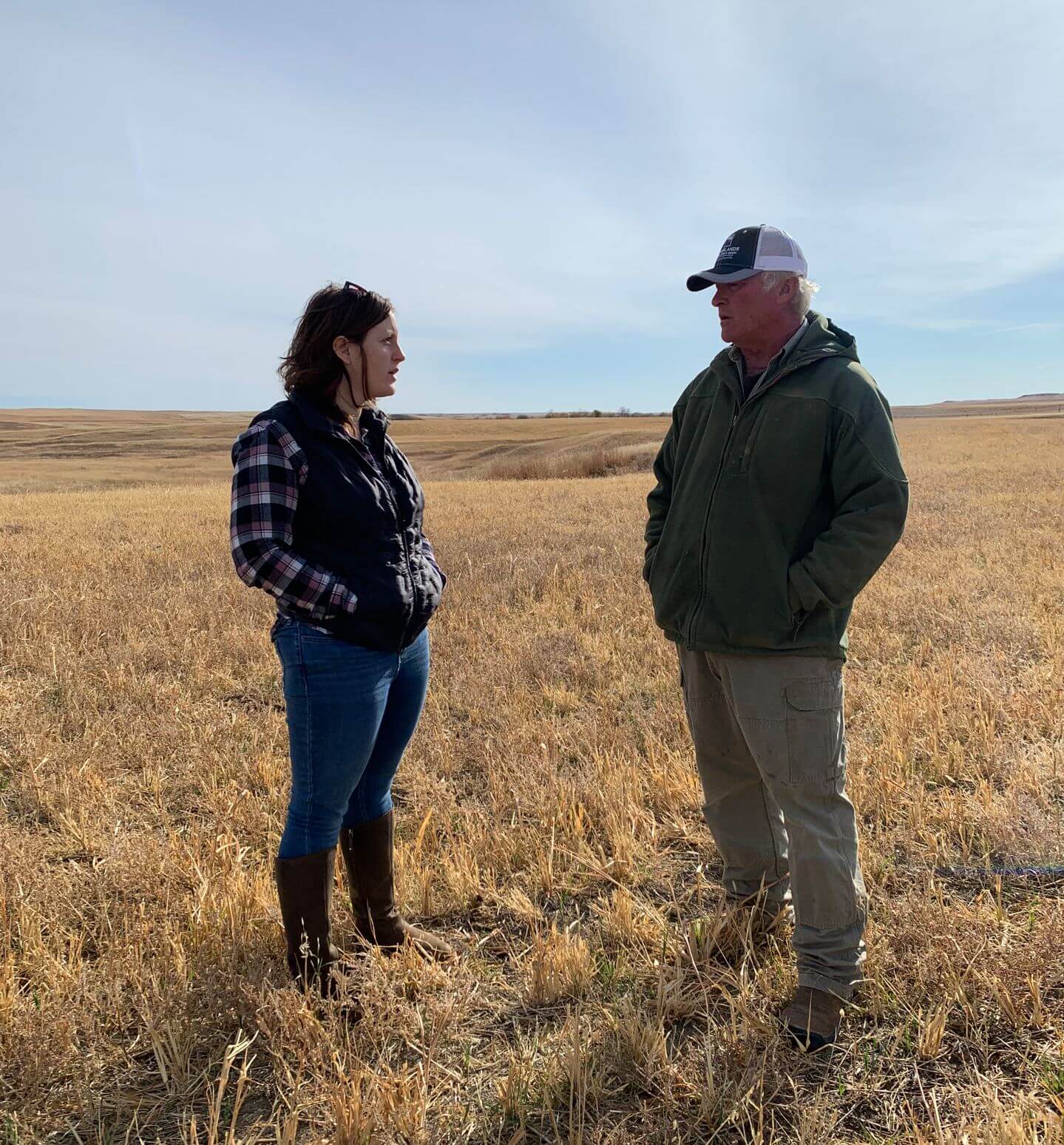
LANDOWNER SPOTLIGHT
GARY KREIMAN & FAMILY
Re-imagining Ranching on the Grasslands of Montana
Gary’s passion for the land began at a very young age when he helped his grandfather plant potatoes. His innate stewardship ethic and desire to see the land flourish was challenged by the difficult and unpredictable dynamics of annual crop cultivation. Under pressure from turbulent crop markets, and facing highly erodible soils, Gary—with support from Tanner and Abby—decided to modify the family operation. In 2020, Gary connected with Bird Conservancy through the Northern Great Plains Joint Venture (NGPJV) to explore options to reseed some of his crop fields back to perennial grass. The NGPJV put Gary in contact with Tayler Scherr, Bird Conservancy’s Private Lands Wildlife Biologist based in the Glendive, Montana USDA Natural Resources Conservation Service Office.
Photo left: Tayler talks reseeding with Gary Kreiman on his property. Photo by Angela Dwyer
Gary helped connect Tayler with other landowners interested in reseeding perennial grass. This partnership initiated an immense conservation effort under the USDA Farm Bill’s Environmental Quality Incentives Program to reseed cropland back to grass and develop infrastructure for sustainable grazing operations. Today, Gary and Tayler are working with the World Wildlife Fund (WWF) to restore the majority of the Kreiman Family operation to native grasses. In addition, WWF monitors the ranch’s soils for carbon and the grasslands for breeding birds. Conversion of grasslands to agriculture is one of the most significant threats to native prairies. The Kreiman Family shows the opportunity to change this trajectory and restore perennial grasses by voluntarily collaborating with landowners seeking to conserve their legacies. These partnerships are a win-win solution for grasslands, their obligate birds, and the dedicated land stewards.
ABOUT US
Ensuring a Thriving Conservancy
Building capacity and resiliency
2021 was a strong year for Bird Conservancy of the Rockies as we reached new milestones in achieving our mission. Strong partnerships continued to help us increase the scope, reach and quality of our programs and initiatives. The generosity of people just like you helped us soar even higher.
Ensuring a strong organization for the future is a vital component of our strategic plan, which emphasizes sustainable and adaptive operations, investing in our people and infrastructure, and diversifying our funding streams. Similar to many of our colleagues, our financial performance was impacted by the COVID-19 pandemic.
Despite the continued challenges the ongoing pandemic presented the organization in 2021, we managed to have significant positive net income thanks to our generous donors, management cost saving efforts and the receipt of additional PPP funding. Your continued support of Bird Conservancy will help the organization to thrive and remain resilient during challenging times. Thank you for your commitment to helping us achieve our mission.
The financial information provided here is a 2021 summary. Detailed annual financial statements are available for 2021 – download here.
